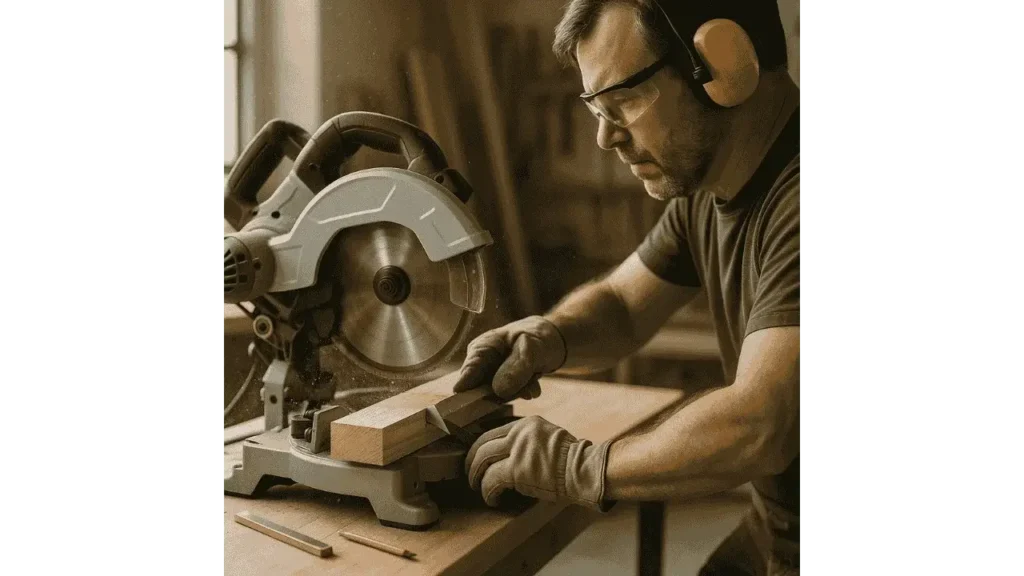A chop saw is a versatile cutting tool designed to make fast, straight cuts across a variety of materials. You’ll find it invaluable for both professional projects and home tasks, as it allows you to work efficiently while maintaining precision. Its primary purpose is to deliver clean, accurate cuts in materials such as metal, wood, and composites. You should always match the blade to the material you’re cutting to ensure optimal performance, reduce wear on the tool, and maintain safety throughout your project. From my experience, choosing the correct blade can make a noticeable difference in both cut quality and efficiency.

Core Applications of a Chop Saw
Construction & Renovation
You can use a chop saw to cut metal pipes, rebar, studs, and other structural components quickly and accurately. For framing or assembly tasks, having a properly clamped workpiece ensures straight cuts every time. From my experience on job sites, using a chop saw for construction projects significantly reduces time compared to hand cutting, while providing precise measurements essential for structural integrity.
Metalworking
Chop saws are excellent for fabricating metal parts, tubing, and bars. You should use abrasive or cold-cut blades depending on the material to maintain efficiency and prevent overheating. I’ve found that selecting the right blade type not only improves cutting speed but also ensures safety, reducing the risk of sparks and material warping during fabrication tasks.
Woodworking & DIY Projects
For woodworking or DIY projects, a chop saw can handle framing, shelves, trim, and furniture components with ease. You’ll notice that even for hobby-level tasks, using a chop saw improves accuracy and reduces fatigue compared to manual saws. In my experience, hobbyists benefit from portable or smaller models, as they allow precise cuts without needing a full workshop setup.
Outdoor & Landscaping Uses
You can use a chop saw for cutting PVC piping, composite boards, or other materials in yard and garden projects. Lightweight or portable models make it easier to handle materials on-site without compromising cut quality. From my experience, having a portable chop saw on hand saves time when working on outdoor projects such as fencing, irrigation systems, or garden furniture assembly.
Specialized Uses
Chop saws are also suitable for cutting plastics, composites, and other non-metal materials where precision is required. In certain scenarios, a chop saw is more efficient than other types of saws because it provides straight, repeatable cuts without additional setup.
“A chop saw allows you to complete repetitive cuts accurately and safely, which is invaluable for both home projects and professional work,” says contractor Jack Harris.
You Might Also Like: How to Sharpen a Chop Saw Blade?
Choosing the Right Chop Saw for Your Application
When selecting a chop saw, you should consider the blade type, abrasive, cold cut, or dry cut, based on the material you intend to cut. Blade size and motor power must align with your cutting requirements to maintain efficiency. Additionally, consider portability and safety features if you plan to move the saw between job sites or use it in a home setting. From my experience, choosing the correct combination of blade, power, and portability can drastically improve both your workflow and overall results.
Safety Tips When Using a Chop Saw
You should always wear proper PPE, including safety goggles, gloves, and hearing protection, when operating a chop saw. Ensure that the workpiece is securely clamped before making any cuts to prevent movement or kickback. Keep your hands and body clear of the blade’s path, and maintain a stable stance while using the saw. Regularly inspect your saw and blade for wear or damage to ensure safe operation.
“Following consistent safety practices reduces accidents and maintains the saw’s performance,” says tool expert Sarah Lopez.
Further Reading: How to Use a Chop Saw?
Maintenance Tips to Extend Blade Life
Clean blades after each use to remove metal shavings, sawdust, or resin, as buildup can affect performance. Store your blades in a dry and safe location to prevent rust or damage. Replace blades when they are worn, chipped, or no longer able to make precise cuts. In my experience, consistent cleaning and storage routines extend the life of both the blades and the saw itself, keeping your tool ready for every project.
Related: How to Change a Chop Saw Blade?
FAQs
What is a chop saw used for in construction?
A chop saw is used in construction to cut metal pipes, rebar, and structural components quickly and accurately.
Can a chop saw be used for woodworking projects?
Yes, a chop saw can cut wood for framing, trim, or DIY projects, as long as the correct blade is installed.
Is a chop saw suitable for metalworking?
Absolutely. It’s widely used to cut steel, aluminum, and other metals with precision.
Can a chop saw be used for DIY home projects?
Yes, a chop saw is useful for cutting shelving, PVC pipes, and metal rods efficiently and safely.
What materials can a chop saw cut?
A chop saw can cut metal, wood, PVC, plastic, and composite materials, depending on the blade type.
Final Takeaways
“Using the correct blade and taking safety seriously ensures professional results with every cut,” says Jack Harris.
A chop saw is a versatile tool suitable for construction, metalworking, woodworking, and DIY tasks. By using the right blade and following safety precautions, you can achieve precise cuts and prolong the life of your tool. Selecting the appropriate chop saw for your specific application enhances both efficiency and safety, making it a valuable addition to any home workshop or professional toolkit.
- How to Cut a Straight Line with a Jigsaw? - October 31, 2025
- How to Cut a Circle with a Jigsaw? - October 31, 2025
- Can You Cut Acrylic with a Jigsaw? - October 31, 2025
